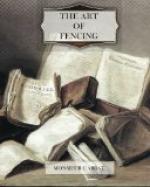You must observe, that between the first and second Motion, there is no Interval, but between the second and third there is, in order to see where the Enemy gives Light: This Interval must be shorter or longer according as your Disposition or Practice is more or less.
CHAP. XXV.
Of the Good Effects of a nice Discernment of the Eye.
In Fencing, there is the Foreseen, and the Unforeseen; the Foreseen is the Effect of the Understanding and of the Will, and the Unforeseen is the Effect of the Discernment of the Eye, and of Custom; which being upheld by this Quality, has no sooner discerned an Action or Opening of the Enemy, than all the Parts which are to act, display themselves to oppose or attack him, as if they depended on the Eye. To be convinced of this Truth, you may reflect on READING, wherein, as soon as the Eye has discerned the Words, the pronouncing them follows as quick as in a studied Discourse; the Eye and Tongue being so disposed by Custom, as to do it without immediately reflecting. Indeed before they cou’d arrive to this, the Understanding and the Will were necessary, which having been united for a certain Time, have communicated such a Habit to these Parts, as to make them act as it were of themselves.
In order to acquire this Quality in Fencing, it is necessary that the Master, in his Lessons, shou’d shew what Opportunities are to be favourably laid hold of, two opposite Actions at one and the same Time, That whilst he is uncovering some Part of his Body, he cannot, at the same Instant, parry, because by the Parade, it must be covered; so that by making them make their Thrusts, and other Motions, by the Discernment of the Eye, they find themselves by Practice ready to oppose all the Motions of the Antagonist without the Assistance of the Will. This Method is indeed a little more tedious in the Beginning, but it afterwards becomes shorter and more certain.
If you have not had Practice enough to make the Discernment of the Eye thus habitual, you must observe what Motions your Action causes in the Adversary, by making a Half, or Home-thrust, in order to discover whether the Enemy has recourse to the Parade, or to the Time: If he goes to parry, you must observe his Manner, in order to make a Feint resembling the same Thrust, and to push at the Part where you observed him to give the Light; and if he goes to the Time, you also make a Feint, preparing yourself for the parade and Rispost, or to take a Time contrary to his.




